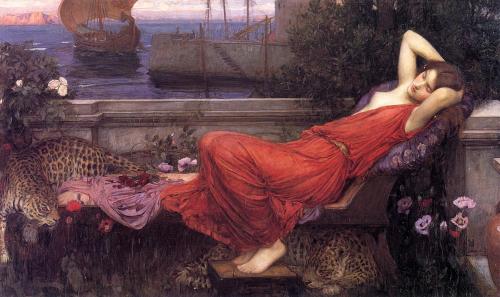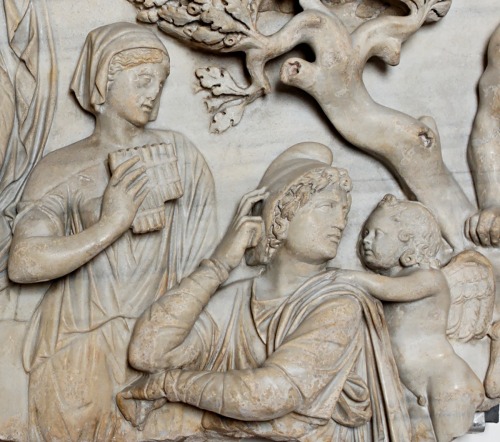#heroides
Ariadne (1898), by J.W. Waterhouse
Another painting based on the 21 letters from Ovidius, collectively known under the name Heroides. The story of Ariadne is most renowned from her helping her beloved Theseus to kill the Minotaur and escape out of the labyrinth that her father had built. She did this by giving him a ball of thread so that he could find his way back. Here she is shown sleeping on a bench, while her lover is leaving her behind and sails away. The two panthers represent the god Dionysus who seduces her and makes her his wife.
In the Vatican Museum, there is a marble Hellenistic sculpture showing Ariadne in almost the same pose as on this painting. Waterhouse must have used it as a model. There are also obvious resemblances with the painting of Saint Cecilia (1895): the ship in the background, the balustrade separation and the sleeping woman to name just a few. In 1895, there was a large exhibition of Venetian art in London and its effect on his paintings is undeniable. Waterhouse becomes more and more influenced by the paintings of Botticelli and other works from the Italian Renaissance.
Post link
Phyllis and Demophoön (1905), by J.W. Waterhouse
Princess Phyllis was turned into an almond tree by the gods to punish Demophoön, who had broken his vow to marry her. Full of remorse, Demophoön caresses the tree that immediately starts to flower. Because Phyllis forgives him, their souls are reunited, but she does not regain her human body so their love remains spiritual.
Waterhouse had used the theme of bodies transforming into trees earlier in “A Hamadryad” (1893) and he will use it again in “Apollo and Daphne” (1908). The work was originally bought by the Henderson family, but its location was unknown for a long time, until it recently reappeared in a private collection.
Post link
Judgement of Paris
Relief from a Roman sarcophagus - early Hadrian (76-138 AD)
From the left: Hera, Athena Hermes, Aphrodite. Under the tree sits Paris with a winged Eros on his back, to the right of the tree sits what could be Dionysus on the skin of an animal and a nymph, or some other deities representing Paris’ tie with nature.
Notice especially the woman with the pipes between Aphrodite and Paris - she is generally identified as Oinone, Paris’ first wife. We have no account of the existence of a first wife of Paris in our early sources of the myth, but she appears in literature in Ovid’s Heroides 5 (late golden age) and in Lucian’s Dearum judicium (silver age). The pipes she’s holding is our best argument for her identity. Euripides has Paris stroll about on Mt. Ida playing the pan pipes and it is a typical instrument of the herdsman.
Rome, Museo Nazionale Romano - inv. 8563
Post link


Ovid. Heroides : manuscript, [ca. 1500] Illuminations by Christoforo Marjorana.
Houghton Library, Harvard University


Ovid. Heroides : manuscript, [ca. 1500] Illuminations by Christoforo Marjorana.
Houghton Library, Harvard University





